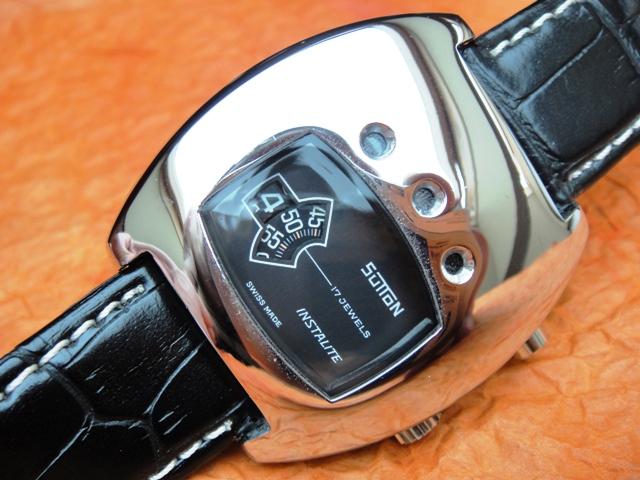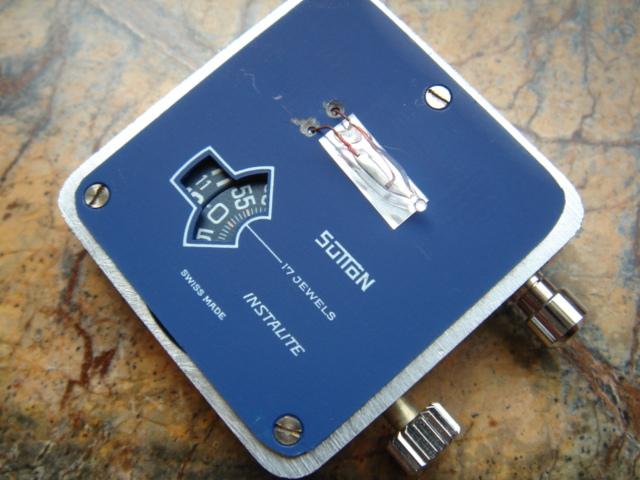-
**** What do we know of L.E.D in 70's watches ****


Why I asked this question is in certain... say Instalite jump hours will do as a model type (can be anything from the 70's really ) they call them l.e.d / Instalite well the articles I read have anyway so while chatting with chruchy we discuss the fact was it a true l.e.d or small think he called it a contact bulb.. I went on to have a look in to it a bit found it quite interesting found a Sutton model I would take as a bulb not l.e.d but could not see the one that started the conversation ..


Found some interesting facts but no real help with the question as one source and graph stated mid 90's for the white light led with the red blue and green being early ...
1 1973 The 'Time Computer' of Omega, caliber 1600, is marketed in 1973 and presented for the first time by Omega at the Basle Fair of 1972. It is the same module as the Pulsar Time Computer caliber 102 with a magnetic setting. The 1601 (1972), 1602 (1974) and 1603 (1975) were soon to follow Omega's 'Time Computer'.
2 1974 Texas Instruments introduces its own line of LED watches at the CES in Chicago. These were the first cheaper LED watches to be sold for less than US $ 100,-.
3 1975 The Bulova Accuquartz Digital LED caliber 228 is presented at the Basle Fair of 1975. This movement has been applied in the the 'Swissonic 2000' line.
4 1974 Caliber ESA 9290 with lateral time display is introduced at the 1974 Basle Fair. The movement was sold by Jaz, France and Mido, Switzerland.
5 1975 The 'Quartz Crystron LED' (cal. 9002), the first LED watch to be produced by Citizen is marketed.
6 1976 The production of a small ladies' caliber ESA 9370 LED starts.
The modules are put to use in watches produced by, amongst others, Certina and Jaz.
7 1976 The LED Touchtron produced by Orient becomes a novelty. When the watch crystal is slightly touched by a fingertip, the LED lights up. Jaz and others followed.
8 Other early LED watch manufacturers are Ricoh Watch, Quantum, Computer Crown, Hudson Harris, New-Port, Nivada (Quartzonic) and Ledo.
9 The first Russian LED watch to be brought on the market is the 2651.
and this is part of a wiki...
White LEDs and the Illumination breakthrough...
The attainment of high efficiency in blue LEDs was quickly followed by the development of the first white LED. In this device a Y
3Al
5O
12:Ce (known as "YAG") phosphor coating on the emitter absorbs some of the blue emission and produces yellow light through fluorescence. The combination of that yellow with remaining blue light appears white to the eye. However using different phosphors (fluorescent materials) it also became possible to instead produce green and red light through fluorescence. The resulting mixture of red, green and blue is not only perceived by humans as white light but is superior for illumination in terms of color rendering, whereas one cannot appreciate the color of red or green objects illuminated only by the yellow (and remaining blue) wavelengths from the YAG phosphor.

Illustration of
Haitz's law, showing improvement in light output per LED over time, with a logarithmic scale on the vertical axis
The first white LEDs were expensive and inefficient. However, the light output of LEDs has increased exponentially, with a doubling occurring approximately every 36 months since the 1960s (similar to Moore's law). This trend is generally attributed to the parallel development of other semiconductor technologies and advances in optics[citation needed] and materials science, and has been called Haitz's law after Dr. Roland Haitz.[39]
The light output and efficiency of blue and near-ultraviolet LEDs rose as the cost of reliable devices fell: this led to the use of (relatively) high-power white-light LEDs for the purpose of illumination which are replacing incandescent and fluorescent lighting.[40][41]
White LEDs can now produce over 300 lumens per watt of electricity while lasting up to 100,000 hours.[42]Compared to incandescent bulbs, this amounts not only to a huge increase in electrical efficiency, but a similar or better prorated cost for the bulbs.
But was wondering what other had thoughts on this know a few members are into old vintage digital's and have repaired them and the like so might be a simple answer to this or maybe not ?
Be fun to here your views and any diagrams, pdf and the like on the subject and or any others things to do with early digital's come to think of it 
As always Ismy 
“Youth may outrun the old, but not outwit.”
-
Post Thanks / Like - 5 Likes




 Likes:
Likes: 















 Reply With Quote
Reply With Quote

